When Do Jellies and Jams Expire?

9 Ways to Relieve Anxiety
January 23, 2025
Learn fitness from scratch
January 23, 2025Making your favorite fruits into jams and jellies has always been a way to keep summer essences fresh for longer. While ripe fruit can only last for a few days, preserved items can last for months, providing some much-needed sweetness during the winter. Naturally, we would like such items to last for a while, as this is what they were originally used for, but they will not be kept indefinitely.
How Long Do Jellies and Jams Last?
Store-Bought Jams and Jellies
Store-bought jellies and jams have a longer shelf life than homemade ones and can usually last for 12-18 months. If you buy from a store, you can check the expiration date to check if it’s still fit for consumption. However, this can only tell you how long your unopened food will stay fresh. Store-bought jellies can last for about 6 months after opening, but it’s best to consume them as soon as possible as they will decrease in freshness after opening.

Homemade Jams and Jellies
When it comes to homemade jellies, unfortunately, they tend not to last that long. If stored properly, a small batch of unopened jars of jam can last around 6-12 months (don’t forget to mark the jars with the date the jelly was made!). )。 Be sure to use it within one year of canning. Also, make sure that the homemade jam is properly sealed in a water bath or pressure jar. Otherwise, they may have gone bad before they were opened.
Homemade jellies and jams, once opened, can last anywhere from one to three months in the refrigerator, depending on the type of produce used. Just like marking the date the jam was made, you may also want to add an opening date so that you can use it when it’s still at its best. And, while they have a longer shelf life, you can also put a piece of masking tape on store-bought jars to show when they were opened.
Handle Jars and Bottles
Before opening any homemade or commercially produced jars, store them in a cool, dry place, away from sunlight and high temperatures, to maximize their shelf life. Once opened, all jams and jellies should be refrigerated to prevent spoilage.
Also, be aware of cross-contamination. If you dip twice with a knife and add a product with a shorter shelf life, this will cause the jam to spoil faster and create mold. Of course, if you find that a new sample has grown on your favorite peach jam without any contamination or tampering, then it’s time to throw away that jar and find a new jam for your toast.
Interestingly, the kind of fruit in the jam affects its shelf life. Fruits with more acid in jam last longer than fruits with lower acid content.


